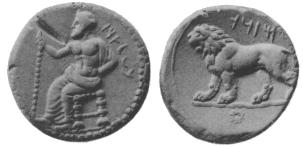
FIG. 357.



[Babelon, Perses Achém., pp. xix, xiviii f.; Imhoof-Blumer, Num. Zeit., 1895, pp. 1 ff., 1905, pp. 1 ff.; Howorth, Num. Chron., 1904, pp. 1 ff.]
In B.C. 331 the Persian satrap Mazaeus surrendered Babylon to Alexander the Great. Reappointed governor, he ruled until his death in 328. To him and to his successors have been assigned several groups of coins, mostly of thick fabric with a characteristic edge. The attribution to the Babylonian mint has been disputed, and is of course somewhat conjectural, but none better has been suggested in its place.

AR Attic tetradr. |
Also gold double darics of the same type as the ordinary Persian darics.
See infra under Persia, p. 828.
Successors of Mazaeus (Stamenes, Archon), B.C. 327-321.
Gold double darics and darics, uninscribed silver tetradrachms and divisions of the same types as those of Mazaeus, and silver Alexandrine tetradrachms with names of Alexander or Philip III.
Seleucus, B.C. 321-316; Peithon, B.C. 316 to circa 306; Seleucus, B.C. 312 to circa 306.
Gold double darics(?), and silver Attic tetradrachms as before,
especially those with symbols anchor and head of horned horse. Shortly before B.C. 306 Seleucus began to issue from Babylon or other
eastern mints coins with his own types, the transition to which is given
by the following gold tetradrachms and bronze coins with Ptolemaic obverse
(see supra, p. 756).
| Head of Alexander the Great in elephant’s skin head-dress, as on coins struck by Ptolemy I. | Nike with wreath and standard; symbol, head of horned horse
. [Num. Zeit., 1895, Pl. II. 1] AV Attic Tetradr. |
| Head of Zeus. | Elephant. [Ibid., Pl. II. 2] AR Attic Tetradr. |
These are followed by coins with the name of Seleucus. For the Babylonian
coinage of the revolting satraps Molon (B.C. 222-220) and Timarchus (B.C.
162) see the series of the Kings of Syria (pp. 761 and 764).